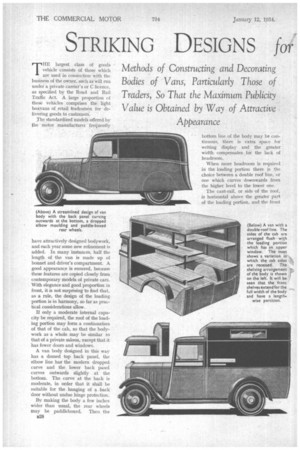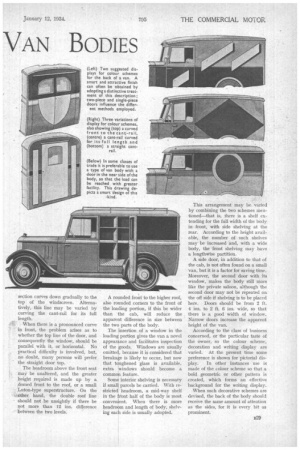STRIKING DESIGNS for
Page 46

Page 47

If you've noticed an error in this article please click here to report it so we can fix it.
VAN BODIES
Methods of Constructing and Decorating Bodies of Vans, Particularly Those of
Traders, So That the Maximum Publicity
Value is Obtained by Way of Attractive Appearance
THE largest class of goods vehicle consists of those which are used in connection with the business of the owner, such as will run under a private carrier's or C licence, as specified by the Road and Rail Traffic Act. A large proportion of these vehicles comprises the light boxvans of retail tradesmen for delivering goods to customers.
The standardized models offered by the motor manufacturer frequently have attractively designed bodywork, and each year some new refinement is added. In many instances, half the length of the van is made up of bonnet and driver's compartment. A good appearance is ensured, because these features are copied closely from contemporary models of private cars.
With elegance and good proportion in front, it is not surprising to find that, as a rule, the design of the loading portion is in harmony, so far as practical considerations allow.
If only a moderate internal capacity be required, the roof of the load ing portion may form a continuation of that of the cab, so that the bodywork as a whole may be similar to that of a private saloon, except that it has fewer doors and windows.
A van body designed in this way has a domed top back panel, the elbow line has the modern dropped curve and the lower back panel curves outwards slightly at the bottom. The curve at the back is moderate, in order that it shall be suitable for the hanging of a back door without undue hinge protection.
By making the body a few inches wider than usual, the rear wheels may be paddleboxed. Then the bottom line of the body may be continuous, there is extra space for writing display and the greater width compensates for the lack of headroom.
When more headroom is required in the loading portion there is the choice between a double roof line, or one which curves downwards from the higher level to the lower one. The cant-rail, or side of the roof, is horizontal above the greater part of the loading portion, and the front section curves down gradually to the top of the windscreen. .Alternatively, this line may be varied by curving the cant-rail for its full length.
When there is a pronounced curve in front, the problem arises as to whether the top line of the door, and consequently the window, should be parallel with it, or horizontal. No practical difficulty is involved, but, no doubt, many persons will prefer the straight door top.
The headroom above the front seat may be unaltered, and the greater height required is made up by a clamed front to the roof, or a small Luton-type superstructure. On the .tattier hand, the double roof line should not be unsightly if there be not more than 12 ins, difference between the two levels. A rounded front to the higher roof, also rounded corners to the front of the loading portion, if this be wider than the cab, will reduce the apparent difference in size between the two parts of the body.
The insertion of a window in the loading portion gives the van a novel appearance and facilitates inspection of the goods. Windows are usually omitted, because it is considered that breakage is likely to occur, but now that toughened glass is available, extra windows should become a common feature.
Some interior shelving is necessary if small parcels be carried. With lestricted headroom, a mid-way shelf in the front half of the body is most convenient. When there is more headroom and length of body, shelving each side is usually adopted. This arrangement may be varied by combining the two schemes mentioned—that is, there is a shell extending for the full width of the body in front, with side shelving at the rear. According to the height available, the number of such shelves may be increased 'and, with a wide body, the front shelving may have a lengthwise partition.
A side door, in addition to that of the cab, is not often found on a small van, but it is a factor for saving time. Moreover, the second door with its window, makes the body still more like the private saloon, although the second door may not be repeated on the off side if shelving is to be placed here. Doors should be from 2 ft. 4 ins. to 2 ft. 6 ins, wide, so that there is a good width of window. Narrow doors increase the apparent height of the van.
According to the class of business concerned, or the particular taste of the owner, so the colour scheme, decoration and writing display are varied. At the present time some preference is shown for pictorial dis
play. In other instances use is made of the colour scheme so that a bold geometric or other pattern is created, which forms an effective background for the writing display.
When such decorative schemes are devised, the back of the body should receive the same amount of attention as the sides, for it is every bit as prominent.




































































































